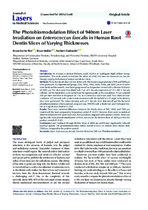| dc.description.abstract | The main etiological factor of pulpal and periapical
infections is the invasion of bacteria into the pulpal
and endodontic systems.1
Successful treatment of these
infections would require the removal and/or destruction
of these microorganisms and create an effective coronal
and apical seal to prohibit the reinfection of bacteria and
influx of nutrients into the endodontic system. The ability
of bacteria to penetrate deep into the dentin tubules and
to form biofilms as well as the adhesion of certain bacteria
to the dentin walls makes the destruction and removal of
bacteria from the three-dimensional dentinal network
a challenging task.2,3 Due to the complexity of this
network, about 30%-45% of the root canal system escapes
chemo-mechanical instrumentation4
as per the normal
endodontic procedure with the dentist. Lasers have been
used as an additional step to kill bacteria that could not be
reached by chemo-mechanical instrumentation. Studies
show that in favourable conditions, bacteria can penetrate
to a depth of more than 1000 μm into the dentinal tubules.2
Numerous previous studies have been conducted to
evaluate the bactericidal effect of various wavelengths
of lasers, but most of these studies were conducted on
dentine slices of 100, 300, 500, and 1000 μm.5-7 They were
conducted with dentine samples up to 1000 μm, therefore
limiting our understanding as to the effects of lasers and
biocides, with one study beyond 2000 μm.8
This in vitro
study aimed to compare the photobiomodulation effect of
a 940 nm laser on Enterococcus faecalis through varying
thicknesses of human root dentin slices. | en_US |

